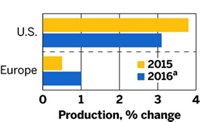Advertisement
Grab your lab coat. Let's get started
Welcome!
Welcome!
Create an account below to get 6 C&EN articles per month, receive newsletters and more - all free.
It seems this is your first time logging in online. Please enter the following information to continue.
As an ACS member you automatically get access to this site. All we need is few more details to create your reading experience.
Not you? Sign in with a different account.
Not you? Sign in with a different account.
ERROR 1
ERROR 1
ERROR 2
ERROR 2
ERROR 2
ERROR 2
ERROR 2
Password and Confirm password must match.
If you have an ACS member number, please enter it here so we can link this account to your membership. (optional)
ERROR 2
ACS values your privacy. By submitting your information, you are gaining access to C&EN and subscribing to our weekly newsletter. We use the information you provide to make your reading experience better, and we will never sell your data to third party members.
Business
U.S.: Domestic Manufacturing Slowdown Will Be Offset By Shale Gas Upside
by Melody M. Bomgardner
January 14, 2013
| A version of this story appeared in
Volume 91, Issue 2

The U.S. chemical industry should see a slight uptick in demand this year as end markets such as vehicles and housing gain modest ground. In addition, as production enabled by cheap natural gas comes on-line, domestic manufacturers will be equipped to produce more chemicals for export to growing economies.
This year, U.S. chemical production, excluding pharmaceuticals, is expected to grow by a moderate 1.9%, compared with a 1.5% increase in 2012, according to the American Chemistry Council, a trade group. Last year’s slow, tentative growth will continue into the early part of 2013, due to slowing momentum in U.S. manufacturing, the recession in Europe, and weakness in exports to Asia, ACC’s chief economist, T. Kevin Swift, reports.
Caution by downstream customers will crimp orders for basic chemicals including inorganics, petrochemicals, plastics, and synthetic rubber. In contrast, production of specialty chemicals will be driven by consumer demand for new passenger vehicles and houses, Swift outlines.
To expand business, chemical firms will find growth markets beyond China and Brazil, says Garrett Gee, U.S. chemical advisory services director at the consulting firm PricewaterhouseCoopers. Companies will target countries such as Vietnam, Indonesia, Turkey, and Argentina in order to access “incremental increases in demand as the emerging middle class evolves,” Gee says.
Certain megatrends will also continue, according to Gee. The chemical industry will look to benefit from spending on energy and natural resources, urban infrastructure, consumer goods, health and nutrition, animal and life sciences, clean water, transportation, and communication.
DuPont CEO Ellen J. Kullman mentioned some of the same trends in a December speech. “Our current outlook,” she said, “calls for our 2013 earnings to grow low- to mid-single digits over 2012 as the investments we are making in agriculture and nutrition, industrial biosciences, and advanced materials continue to deliver results, offset by the weakness in titanium dioxide markets.”
Meanwhile, 50 facilities have been announced to capitalize on the country’s new shale gas advantage, according to ACC. They will turn out basic chemicals including ethylene, polyethylene, methanol, and ammonia and are likely to push chemical production higher than consensus estimates this year.
MORE ON THIS STORY
- - World Chemical Outlook
- - Pharmaceuticals: Companies Will Focus On External Partnerships To Improve Productivity
- - U.S.: Domestic Manufacturing Slowdown Will Be Offset By Shale Gas Upside
- - Construction: The Action, Once Again, Is In Developing Countries
- - Europe: Economy And Chemical Industry Are Expected To Stagnate
- - Fine Chemicals: Optimism Prevails Over Uncertainty
- - Asia: Slowdown In China, Although Mild, Is Cause For Concern
- - Petrochemicals: The U.S. Will See A Boom As Europe And Asia Struggle
- - Cleantech: New Funding Will Be Scarce, But Scale-Up Plans Continue
- - Specialties: Growth To Be Fueled By Autos, Electronics
- - Canada: After A So-So 2012, Chemical Firms Prepare For A Brighter Future
- - Instrumentation: Firms Plan For The Long Term Amid Short-Term Uncertainties
- - Middle East: After Years Of Growth, A Profits Squeeze Lies Ahead
- - Advanced Materials: Carbon Fiber, 3-D Printing, Graphene To Make Inroads
- - Latin America: Policymakers, Industry Seek To Boost Competition




Join the conversation
Contact the reporter
Submit a Letter to the Editor for publication
Engage with us on Twitter